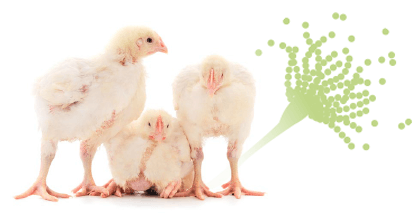OBJECTIVE
OBJECTIVE
Mycotoxins are the biggest challenge for animal feed producers and can be remediated by various methods, but enzymes and microorganisms for deactivating mycotoxins are becoming increasingly popular.
METHODS
METHODS
![]() In order to evaluate the microorganisms’ mycotoxin degradation capacity two flasks were prepared:
In order to evaluate the microorganisms’ mycotoxin degradation capacity two flasks were prepared:
 Control Flask
Control Flask
The Control Flask was prepared with culture medium and the mycotoxins DON, ZEN, AFB1, FB1, OTA and T-2 toxin at a final concentration of 0.2 ppm.
 Test Flask
Test Flask
For the preparation of the Test Flask, on day 1 the microbial culture was inoculated in nutrient broth or mineral salt medium and incubated at 37˚C for 16-20 hours.
⇰ The next day, the mycotoxins DON, ZEN, AFB1, FB1, OTA and T-2 toxin were added to reach a final concentration of 0.2 ppm.
Both flasks were incubated at 37˚C and samples were taken at 0, 2, 6, 12 and 24 hours for analysis of degradation activity using LC-MS/MS.

RESULTS
RESULTS
 The results showed that incubation of the Test Flask with Bacillus sp. for 2 hours resulted in:
The results showed that incubation of the Test Flask with Bacillus sp. for 2 hours resulted in:
- ⇰ Transformation of 26% of AFB1 to AFQ1
- ⇰ Transformation of 25% of OTA to OTA-α and OTA B (very low levels detected)
- ⇰ Transformation of 95% of ZEN to α-Zearalenol (only 39 ppb was detected and this level of α-Zearalenol does not have toxic effects).

Authors
J. Raj*, Z. Jakovčević, H. Farkaš, J. Bošnjak-Neumüller y M. Vasiljević
1PATENT CO, DOO., Vlade Ćetkovića 1A, 24 211, Mišićevo, Serbia
Corresponding author: [email protected]
References
MycoTWIN – MycoKey 2021 INTERNATIONAL CONFERENCE BARI, Italy, 9-12 November 2021




 Micotoxicosis prevention
Micotoxicosis prevention